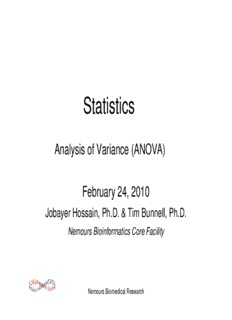Table Of ContentStatistics
Analysis of Variance (ANOVA)
February 24, 2010
Jobayer Hossain, Ph.D. & Tim Bunnell, Ph.D.
Nemours Bioinformatics Core Facility
Nemours Biomedical Research
Class Objectives -- You will Learn:
• Experimental design terminologies
• Analysis of variance (ANOVA) and the
situation it is applicable
• One-way ANOVA
• Multiple comparisons
• How to do ANOVA with SPSS
Nemours Biomedical Research
Experimental Design Terminology
• An Experimental Unit is the entity on which measurement or an
observation is made. For example, subjects are experimental units
in most clinical studies.
• Homogeneous Experimental Units: Units that are as uniform as
possible on all characteristics that could affect the response.
• Randomization is the process of assigning experimental units
randomly to different experimental groups. It is the most reliable
method of creating homogeneous treatment groups, without
involving potential biases or judgments.
Nemours Biomedical Research
Experimental Design Terminology
• Replication is the repetition of an entire experiment or portion of an
experiment under two or more sets of conditions.
• Replication reduces variability in experimental results and increases
the significance and the confidence level with which a researcher can
draw conclusions about an experimental factor
• To establish the significance of an experimental result, replication, the
repetition of an experiment on a large group of subjects, is required.
• If a treatment is truly effective, the average effect of replicated
experimental units will reflect it.
• If it is not effective, then the few members of the experimental units who
may have reacted to the treatment will be negated by the large numbers
of subjects who were unaffected by it.
Nemours Biomedical Research
Experimental Design Terminology
• A Block is a group of homogeneous experimental units. For
example, if an investigator had reason to believe that response of
the medication differs significantly with age difference, he might
choose to first divide the experimental subjects into age groups,
such as under 5 years old, 5-10 years old, and over 10 years old
etc to acquire homogeneity of response of the medication within
age group.
Nemours Biomedical Research
Experimental Design Terminology
• A Factor is a controllable independent variable that is being
investigated to determine its effect on a response. E.g. treatment
group is a factor.
• Factors can be fixed or random
– Fixed -- the factor can take on a finite number of levels and these
are the only levels of interest e.g. treatment group in our data set
is a fixed factor.
– Random -- the factor can take on a wide range of values and one
wants to generalize from specific values to all possible values e.g.
subjects in the data set can be a random factor.
• Each specific value of a factor is called a level. E.g. treatment group:
A, B, and placebo. Then all these are three levels.
Nemours Biomedical Research
Experimental Design Terminology
• A covariate is an independent variable not manipulated by the
experimenter but still affecting the response. E.g. in many
clinical experiments, the demographic variables such as race,
gender, age may influence the response variable significantly
even though these are not the variables of interest of the study.
These variables are termed as covariate.
• Effect is the change in the average response between two
factor levels. That is, factor effect = average response at one
level – average response at a second level.
Nemours Biomedical Research
Experimental Design Terminology
• Interaction is the joint factor effects in which the effect of
one factor depends on the levels of the other factors.
No interaction effect of
Interaction effect of factor A
factor A and B
and B
Nemours Biomedical Research
The basic ANOVA situation
(cid:1)
Type of variables: Quantitative response and Categorical (factor)
predictors (independent variable).
(cid:1)
Main Question: Are mean response measures of different groups
equal?
(cid:1)
One categorical variable with only 2 levels (groups):
(cid:1)
2-sample t-test
(cid:1)
One categorical variable with more than two levels (groups):
(cid:1)
One way ANOVA
(cid:1)
Two or more categorical variable, each with at least two or more
levels (groups) of each:
(cid:1)
Factorial ANOVA
Nemours Biomedical Research
Analysis of variance (ANOVA)
• The analysis of variance (ANOVA) is a technique of decomposing the total
variability of a response variable into:
• Variability due to the experimental factor(s) and…
• Variability due to error (i.e., factors that are not accounted for in the
experimental design).
• The basic purpose of ANOVA is to test the equality of several means.
• A fixed effect model includes only fixed factors in the model.
• A random effect model includes only random factors in the model.
• A mixed effect model includes both fixed and random factors in the model.
Nemours Biomedical Research
Description:To establish the significance of an experimental result, replication, the repetition of an . Fisher's Least Significant Difference (LSD). – Tukey's HSD

